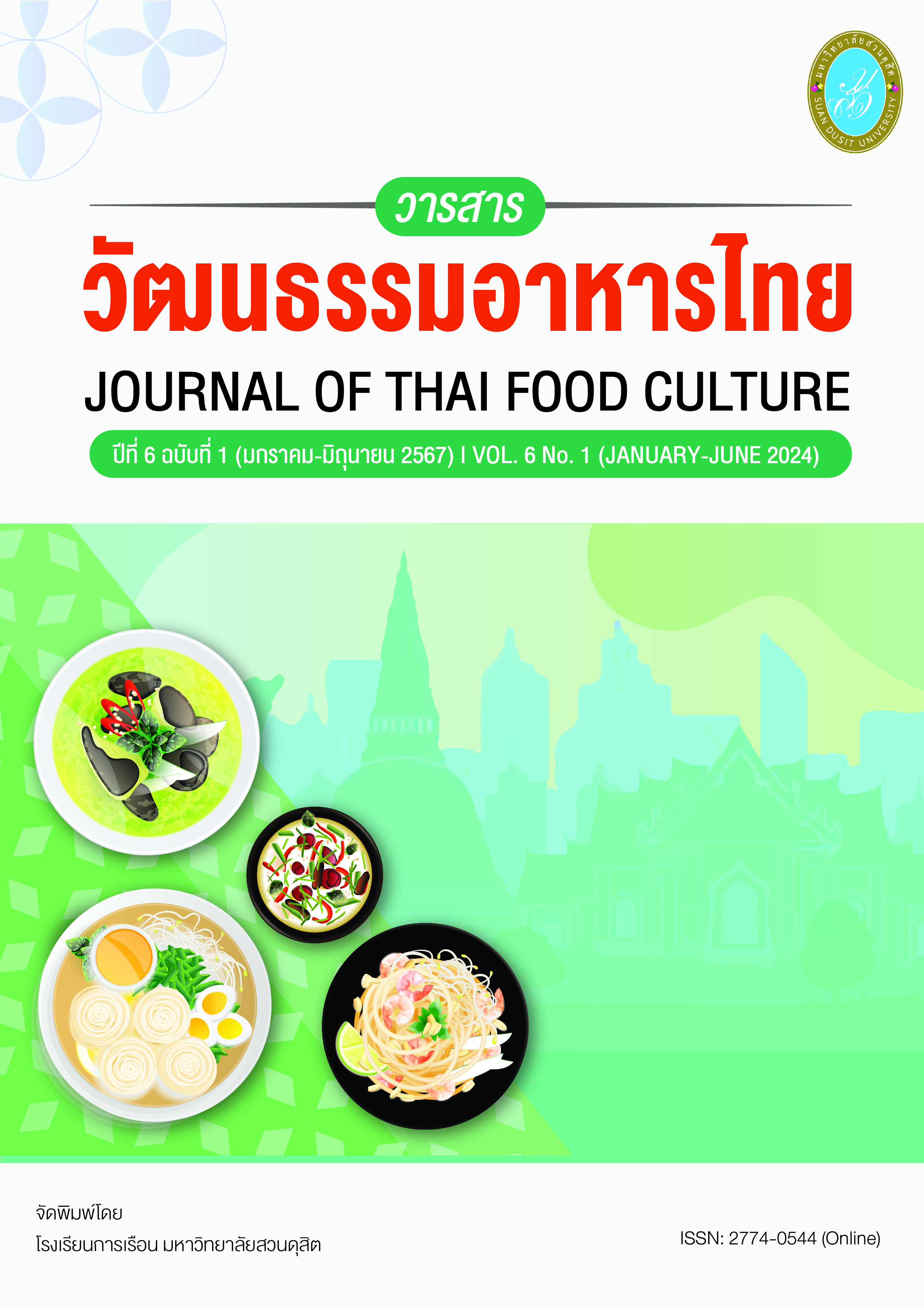แกะสลักผักและผลไม้ : การแกะสลักเพื่อการรับประทาน
คำสำคัญ:
แกะสลักผักและผลไม้ แกะสลักเพื่อการรับประทาน แกะสลักเพื่องานอาหารบทคัดย่อ
การแกะสลักผักและผลไม้ของไทยบ่งบอกถึงเอกลักษณ์ของอาหารไทยที่แสดงถึงความตั้งใจประดิษฐ์ประดอยปรุงแต่งอาหาร เพื่อทำให้อาหารดูน่ารับประทานมากยิ่งขึ้น เพิ่มมูลค่าให้กับอาหารบทความนี้ได้วิเคราะห์การแกะสลักเพื่อการรับประทาน พบว่าช่างแกะสลัก เป็นบุคคลที่เกี่ยวข้องกับการแกะสลักตั้งแต่กระบวนการเตรียม การแกะสลัก และการเก็บรักษาโดยยึดหลักความสะอาด ปลอดภัย ทุกขั้นตอน ผักและผลไม้ที่นำมาแกะสลักจะต้องเลือกที่ใหม่ สด สะอาด และปลอดภัย นอกจากนี้การเก็บรักษาผักผลไม้อย่างถูกวิธี การใช้อุณหภูมิ สถานที่เก็บรักษาที่เหมาะสม มีความสำคัญต่อการรักษาคุณภาพ อุปกรณ์ที่ใช้ในการแกะสลักต้องสะอาด ทำจากวัสดุที่ปลอดภัย สถานที่ในการแกะสลัก ต้องจัดให้สะอาด เป็นระเบียบ สุดท้ายการแกะสลักเพื่อการรับประทานใช้วิธีการแกะสลักอย่างง่ายใช้ลวดลายพื้นฐานไม่สลับซับซ้อน ใช้ระยะเวลาในการแกะสลักที่สั้นเพื่อรักษาคุณภาพของผักผลไม้แกะสลัก
เอกสารอ้างอิง
กรมส่งเสริมวัฒนธรรม กระทรวงวัฒนธรรม. (2559). วัฒนธรรม วิถีชีวิตและภูมิปัญญา. กรุงเทพฯ: บริษัท รุ่งศิลป์การพิมพ์ จำกัด.
คนึงนิจ กัณหะกาญจนะ. (2554). ศิลปะการแกะสลักผักและผลไม้. กรุงเทพฯ: โอเดียนสโตร์.
จอมขวัญ สุวรรณรักษ์ และ นิธิยา รัตนาปนนท์. (2559). เทคโนโลยีการแกะสลักผักและผลไม้. พิมพ์ครั้งที่ 2. กรุงเทพฯ: โอเดียนสโตร์.
ณัฐพงษ์ มุงเมือง ธีระพล เสนพันธุ์ และ วิจิตรา แดงปรก. (2566). การใช้สารเคลือบผิวชนิดบริโภคได้กับสับปะรดตัดแต่งพร้อมบริโภค. วารสารวิทยาศาสตร์บูรพา, 28(1), 284-302.
นันทนา ปรมานุศิษฏ์. (2556). โอชาอาเซียน (ASEAN FLAVORS). กรุงเทพฯ: มติชน.
บุรินทร์ภัทร ชูวงศ์. (2548). งามวิจิตรภาชนะสลักเสลา. กรุงเทพฯ: โอเดียนสโตร์.
พนิตา งามเชื้อชิต. (2560). เนื้อมะม่วงสดตัดแต่ง: สรีรวิทยาและปัจจัยสำคัญที่ส่งผลกระทบต่อคุณภาพ. วารสารเทคโนโลยีการอาหาร มหาวิทยาลัยสยาม, 12(1), 17-34.
พุทธเลิศหล้านภาลัย, พระบาทสมเด็จพระ.(2516). พระราชนิพนธ์กาพย์แห่เรือ.พระนคร: โรงพิมพ์ครุสภา ลาดพร้าว.
ศรุดา นิติวรการ. (2557). อาหารไทย: มรดกทางวัฒนธรรมของชาติ. วารสารวิชาการ มหาวิทยาลัยราชภัฏพระนคร, 5(1), 171-179.
ศักรินทร์ หงส์รัตนาวรกิจ. (2565). ศิลปะการแกะสลักผักและผลไม้ร่วมสมัย. วารสารกระแสวัฒนธรรม, 23(44), 58-69.
อบเชย วงษ์ทอง และ ขนิษฐา พูนผลกุล. (2559). หลักการประกอบอาหาร. พิมพ์ครั้งที่ 13. กรุงเทพฯ: มหาวิทยาลัยเกษตรศาสตร์.
อมราภรณ์ วงษ์ฟัก. (2552). แช่อิ่มผักและผลไม้. กรุงเทพฯ: แม่บ้าน จำกัด.
อร่าม คุ้มทรัพย์. (2543). ผลไม้แปรรูป. กรุงเทพฯ : โรงพิมพ์อักษรไทย.
อาภา จงจิตต์. (2550). การแกะสลักผักสดและผลไม้. พิมพ์ครั้งที่ 5. กรุงเทพฯ: อักษราพิพัฒน์ จำกัด.
Barbagallo, R. N., Chisari, M., & Caputa, G. (2012). Effects of calcium citrate and ascorbate as inhibitors of browning and softening in minimally processed ‘Birgah’eggplants, Postharvest biology and technology, 73, 107-114.
Bhat, T. A., Rather, A. H., Hussain, S. Z., Naseer, B., Qadri, T., & Nazir, N. (2021). Efficacy of ascorbic acid, citric acid, ethylenediaminetetraacetic acid, and 4-hexylresorcinol as inhibitors of enzymatic browning in osmo-dehydrated fresh cut kiwis. Journal of Food Measurement and Characterization, 15(5), 4354-4370.
Feng, Y., Feng, C., Wang, Y., Gao, S., Sun, P., Yan, Z., ... & Zhu, Q. (2022). Effect of CaCl2 Treatment on Enzymatic Browning of Fresh-Cut Luffa (Luffa cylindrica). Horticulturae, 8(6), 473.
Kim, A., Magdaleno, C., Tan, M., Chen, S., & Luo, C. (2022). Investigating the relationship between acid concentration in solution and the onset of enzymatic browning in granny smith apples. The Expedition, 13.
Li, Y., Wills, R. B. H., & Golding, J. B. (2015). Sodium chloride, a cost effective partial replacement of calcium ascorbate and ascorbic acid to inhibit surface browning on fresh-cut apple slices. LWT-Food Science and Technology, 64(1), 503-507.
Liu, B., Fan, X., Shu, C., Zhang, W., & Jiang, W. (2019). Comparison of non‐contact blanching and traditional blanching pretreatment in improving the product quality, bioactive compounds, and antioxidant capacity of vacuum‐dehydrated apricot. Journal of Food Processing and Preservation, 43(3), e13890.
Makule, E., Dimoso, N., & Tassou, S. A. (2022). Precooling and Cold Storage Methods for Fruits and Vegetables in Sub-Saharan Africa—A Review. Horticulturae, 8(9), 776.
Mola, S., Uthairatanakij, A., Srilaong, V., Aiamla-or, S., & Jitareerat, P. (2016). Impacts of sodium chlorite combined with calcium chloride, and calcium ascorbate on microbial population, browning, and quality of fresh-cut rose apple. Agriculture and Natural Resources, 50(5), 331-337.
Moon, K. M., Kwon, E. B., Lee, B., & Kim, C. Y. (2020). Recent trends in controlling the enzymatic browning of fruit and vegetable products. Molecules, 25(12), 2754.
Nadeem, A., Ahmed, Z. F. R., Hussain, S. B., Omar, A. E. D. K., Amin, M., Javed, S., ... & Mira, A. M. (2022). On-Tree Fruit Bagging and Cold Storage Maintain the Postharvest Quality of Mango Fruit. Horticulturae, 8(9), 814.
Suttirak, W., & Manurakchinakorn, S. (2010). Potential application of ascorbic acid, citric acid and oxalic acid for browning inhibition in fresh-cut fruits and vegetables. Walailak Journal of Science and Technology (WJST), 7(1), 5-14.
Tsouvaltzis, P., & Brecht, J. K. (2017). Inhibition of enzymatic browning of fresh‐cut potato by immersion in citric acid is not solely due to pH reduction of the solution. Journal of food processing and preservation, 41(2), e12829.
Venkatachalam, K. (2015). The different concentrations of citric acid on inhibition of Longkong pericarp browning during low temperature storage. International Journal of Fruit Science, 15(4), 353-368.
ดาวน์โหลด
เผยแพร่แล้ว
รูปแบบการอ้างอิง
ฉบับ
ประเภทบทความ
สัญญาอนุญาต
ลิขสิทธิ์ (c) 2024 โรงเรียนการเรือนสวนดุสิต

อนุญาตภายใต้เงื่อนไข Creative Commons Attribution-NonCommercial-NoDerivatives 4.0 International License.
ลิขสิทธิ์ต้นฉบับที่ได้รับการตีพิมพ์ในวารสารวัฒนธรรมอาหารไทย ถือเป็นกรรมสิทธิ์ของโรงเรียนการเรือน มหาวิทยาลัยสวนดุสิต ห้ามผู้ใดนำข้อความทั้งหมดหรือบางส่วนไปพิมพ์ซ้ำ เว้นแต่จะได้รับอนุญาตอย่างเป็นลายลักษณ์อักษรจากโรงเรียนการเรือน มหาวิทยาลัยสวนดุสิต นอกจากนี้ เนื้อหาที่ปรากฎในบทความเป็นความรับผิดชอบของผู้เขียน ทั้งนี้ไม่รวมความผิดพลาดอันเกิดจากเทคนิคการพิมพ์


